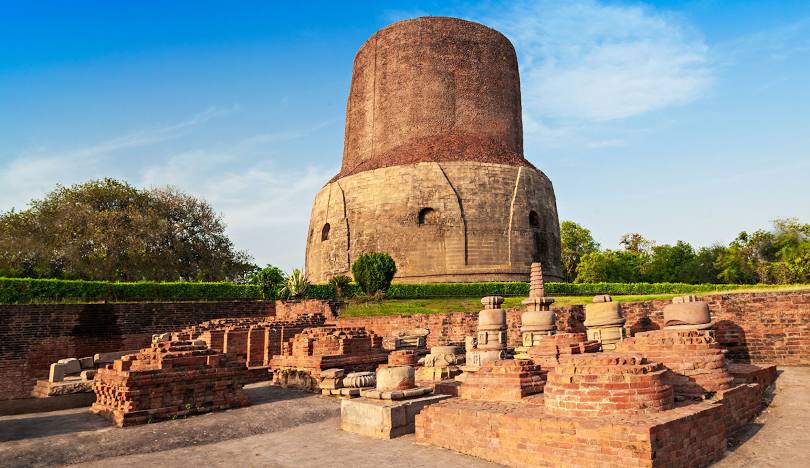
Varanasi Sarnath
Varanasi Sarnath: A Journey Through Spirituality and History
Varanasi, the spiritual capital of India, is a city renowned for its temples, ghats, and cultural richness. A short distance from Varanasi lies Sarnath, a place of immense historical and religious significance. Famous as the site where Lord Buddha delivered his first sermon, Sarnath holds a cherished spot in the hearts of Buddhists and history enthusiasts alike. Let us delve into the wonders of Varanasi Sarnath and explore why this destination captivates travelers from around the globe.
Why Visit Varanasi Sarnath?
- Historical Importance: Sarnath is one of the four main pilgrimage sites for Buddhists worldwide.
- Spiritual Significance: It is where Lord Buddha taught the Dharma for the first time.
- Architectural Marvels: Ancient stupas, monasteries, and the iconic Ashoka Pillar.
- Tranquility: A peaceful retreat from the bustling city of Varanasi.
Key Attractions in Varanasi Sarnath
Attraction | Highlights |
Dhamek Stupa | Marks the spot of Buddha’s first sermon. |
Chaukhandi Stupa | A grand structure commemorating Buddha’s arrival in Sarnath. |
Mulagandha Kuti Vihar | A modern temple with impressive frescoes and a serene ambiance. |
Sarnath Archaeological Museum | Houses ancient relics, including the Lion Capital of Ashoka. |
Ashoka Pillar | Symbol of India’s heritage and Buddhist teachings. |
Deer Park | A serene spot believed to be where Buddha met his first disciples. |
Tibetan Temple | Reflects Tibetan architecture and Buddhist culture. |
The History of Varanasi Sarnath
Sarnath, located about 10 kilometers from Varanasi, holds a pivotal place in Buddhist history. After attaining enlightenment in Bodh Gaya, Lord Buddha traveled to Sarnath, where he delivered his first sermon to his five disciples. This event, known as the Dhammacakkappavattana Sutta, marked the foundation of the Buddhist Sangha.
The Mauryan Emperor Ashoka, a devout follower of Buddhism, significantly contributed to Sarnath’s development. He erected the Ashoka Pillar, adorned the site with stupas, and built monasteries, making it a center of learning and spirituality.
Key Attractions in Varanasi Sarnath
- Dhamek Stupa
- Constructed in 249 BCE by Emperor Ashoka.
- Height: 43.6 meters; Diameter: 28 meters.
- Features intricate carvings and inscriptions.
- Symbolizes the location of Buddha’s first sermon.
- Chaukhandi Stupa
- Originally a terraced temple; later modified into a stupa.
- Built to commemorate Buddha’s meeting with his disciples.
- Offers a panoramic view of the surroundings.
- Mulagandha Kuti Vihar
- A modern Buddhist temple built by the Mahabodhi Society.
- Features murals depicting Buddha’s life, painted by Kosetsu Nosu.
- Houses a sacred Bodhi tree sapling brought from Sri Lanka.
- Sarnath Archaeological Museum
- India’s oldest archaeological museum.
- Displays the Lion Capital of Ashoka, India’s national emblem.
- Showcases artifacts like sculptures, coins, and pottery from ancient Sarnath.
- Ashoka Pillar
- Erected by Emperor Ashoka in the 3rd century BCE.
- Made of polished sandstone.
- Features four lions back-to-back, symbolizing power and courage.
- Deer Park
- Known as Isipatana in ancient texts.
- Associated with Buddha’s first sermon.
- A peaceful location ideal for meditation and reflection.
- Tibetan Temple
- Built by Tibetan Buddhists to preserve their culture and teachings.
- Adorned with Thangka paintings and a prayer wheel.
- Offers a glimpse into Tibetan spirituality.
Tips for Visiting Varanasi Sarnath
- Best Time to Visit: October to March, when the weather is pleasant.
- How to Reach:
- By Air: Varanasi’s Lal Bahadur Shastri Airport is the nearest.
- By Train: Varanasi Junction is well-connected to major cities.
- By Road: Regular buses and taxis are available from Varanasi.
- Dress Modestly: Respect the sanctity of the place.
- Guided Tours: Consider hiring a guide to understand the historical context better.
- Photography: Allowed in most areas but avoid using flash in museums.
Cultural and Spiritual Insights
Sarnath is more than just a tourist destination; it is a beacon of spirituality. Visitors often describe experiencing a sense of peace and introspection here. The teachings of Buddha resonate through the serene atmosphere, making Sarnath a transformative experience for many.
- Participate in meditation sessions conducted by Buddhist monks.
- Observe rituals and offerings made at the stupas.
- Learn about Buddhism through interactive exhibits at the museum.
Nearby Attractions
While exploring Varanasi Sarnath, consider visiting these nearby attractions:
- Kashi Vishwanath Temple: One of the 12 Jyotirlingas dedicated to Lord Shiva.
- Ganga Ghats: Witness the grandeur of the Ganga Aarti at Dashashwamedh Ghat.
- Banaras Hindu University (BHU): A hub of education and culture.
- Ramnagar Fort: A historic fort on the eastern bank of the Ganges.
Sample Itinerary for Varanasi Sarnath
Day 1: Exploring Varanasi
- Morning: Visit Kashi Vishwanath Temple.
- Afternoon: Stroll along the ghats and enjoy a boat ride.
- Evening: Witness the Ganga Aarti.
Day 2: Day Trip to Sarnath
- Morning: Explore Dhamek Stupa and Chaukhandi Stupa.
- Afternoon: Visit the Archaeological Museum and Mulagandha Kuti Vihar.
- Evening: Relax at Deer Park and meditate.
Conclusion
Varanasi Sarnath is a destination that seamlessly blends history, spirituality, and culture. From ancient stupas to serene parks, every corner of Sarnath tells a story of enlightenment and devotion. Whether you seek spiritual solace or historical insights, Varanasi Sarnath offers an unforgettable experience. Plan your visit today to embark on a journey that touches the soul and inspires the mind.
Focus Keyword Usage Summary
- SEO Title: Varanasi Sarnath: A Spiritual and Historical Guide
- Meta Description: Discover the profound history and spiritual significance of Varanasi Sarnath.
- Focus Keyword Placement:
- Used in title tag, H1, H2, and throughout the content.
- Keyword density maintained between 1% and 2%.
- Appears within the first 10% of the article.
- Incorporated in bullet points and table.

Leave your comment